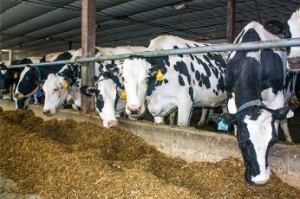Dairy farming

Your management style will play a big part in deciding between things like headlocks or a feed rail system. Answers to questions like the following should influence your decision before anything else:
- Do you plan on handling group activities (for example, vaccinations and pregnancy checks) inside or outside of the barn?
- Are you comfortable working inside the barn?
- Or do you prefer to work in a dedicated treatment area?
Farmers looking for more cost-effective solutions are often inclined to go with a feed rail, as it offers a lower initial investment compared to headlocks. However, it’s important to factor in all costs such as labor, which typically is the second highest operational cost, as well as the size of the designated treatment facility. To really determine what the difference in price is for each system, we encourage you to prorate initial costs and add that to the expected ongoing labor costs. This will better help you determine what the true cost, annually, will be for each system before deciding if installing a feed rail is cheaper than headlocks.

Headlocks, although a higher initial cost, save you more time on the day-to-day handling activities by effectively restraining individuals or groups of animals. You are able to eliminate the time needed to move the animal from the pen it was sorted into at milking to the treatment area and return the animal back to the original pen after treatment. Headlocks allow you to treat animals in a familiar space while the animals continue to eat. Headlocks also offer better space utilization at the feedbunk, through proper indexing, which allows more animals to eat uninterrupted.
In fact, research indicates that headlocks reduce competitive interactions and displacement at the feedbunk by 21 percent. This allows the less dominant animals the room they need to eat their share of the feed. This study also showed that while more dominant cows spent on average 18 minutes longer eating when using feed rails, there was a more consistent feeding time across the entire herd when using headlocks.
Management style will also play a huge part in the decision-making process. Some operators don’t like to work in the barn, preferring instead a dedicated treatment area that allows them to keep all their equipment in a central location near the vet room.
To make this system work properly, you’ll need a sorting area large enough to hold an entire group and the treatment facilities. And, if you’re intending on having “just-in-time” treatments (including breeding) so that the animals are walking back to their pen with their herd mates after milking, your labor will need to be sufficient to ensure treated cows are moving out at the same pace that their herd mates are being milked or leaving the parlor.
The reality is that sorting gates do fail for numerous reasons, and there will be times when the cow “escapes” and you (or your staff) have two choices: Go find the cow and bring her back, or sort her out at the next milking. Both options also come at a price.
Feed rails allow for some flexibility and give you the opportunity to adjust the rail height to accommodate different cow sizes. However, there is also a risk in herds where there is a greater difference in the animals’ size that smaller animals will be able to escape into the feed lane. Installing a rail that can be adjusted to fit the cows’ size will reduce risk of repetitive neck injuries.
If you are comfortable treating animals in the barn, there is a lot to be said for providing a less traumatic handling experience with headlocks. Treating cows in familiar surroundings where they have the option to have a drink upon returning from milking and are able to eat while waiting ensures that milk production isn’t compromised and that unnecessary stress is kept to a minimum. You can also treat a large group of animals in the same time it would take to treat and return just a few, if using a designated treatment facility for all treatments.
As in most things, there is no clear-cut right or wrong answer; it all comes down to your management style and what works best for your facility. Take the time to do your research; consider the estimated annual cost and potential future management changes; and think about this investment as more than just a purchase today. Your future self will thank you. ![]()
Sue Hagenson has been in the dairy industry her whole life and managed farms in Uruguay, China and New Zealand.

-
Sue Hagenson
- International Sales Representative
- Artex Barn Solutions Ltd.
PHOTO 1: When planning a barn with a feed rail at the bunk, a separate area for breeding and treatments will need to be part of the design.
PHOTO 2: Headlocks allow you to treat animals in familiar spaces while they continue to eat. Photos by Peggy Coffeen.






















